Is the “tech stack bloat” battle your CRO’s fighting against actually a problem for research teams, or is this efficiency-at-all-costs mentality keeping research teams from being, well, efficient?
As one participant in our 2025 Research Budget Report said, “It's so difficult and time-consuming to determine and communicate ROI for UX tools. Often, executives don't see the big picture until the software has been purchased and is being put to use, but it's nearly impossible to get to that point without serious trust and deference to a UX team.”
Turns out, the right tool for each job doesn't just make work easier—it makes every dollar work harder. Teams with robust research tool stacks don't only report a 36% higher budget satisfaction than their minimally-equipped counterparts, but they also perceive their research dollars as more impactful.
We originally uncovered that more than a fifth of budget stakeholders struggle with justifying tool/software purchases—the number one hardest budget justification. And 36% of stakeholders said that they wished they could spend more of their budget on tools.
Taking a deeper dive into the dataset, we explored the relationship between research budgets and tool and software, looking at tool stack size by:
- Budget size
- Company size
- Research maturity
- Industry
- Budget controller
Here’s what we found:
Higher budgets generally mean more research tools, but there's a surprising dip at the upper-mid level
The most common tool stack remains 2-5 tools across all budget levels, but larger budgets generally mean more tools. Only 10% of low-investment teams have more than five tools, compared to ~30% of mid-level teams and 50% of high-investment teams. Low-investment teams are most likely to have minimal setups (25% have 0-1 tools), while high-investment teams are most likely to have extensive toolkits (23% have 10+ tools).
Surprisingly, upper-mid investment teams actually have more minimal setups than low-mid teams. As theorized in the original report, organizations at this funding level are likely hiring their first dedicated researcher—meaning that while the budget is bigger, less money is available for tools since more goes to headcount.
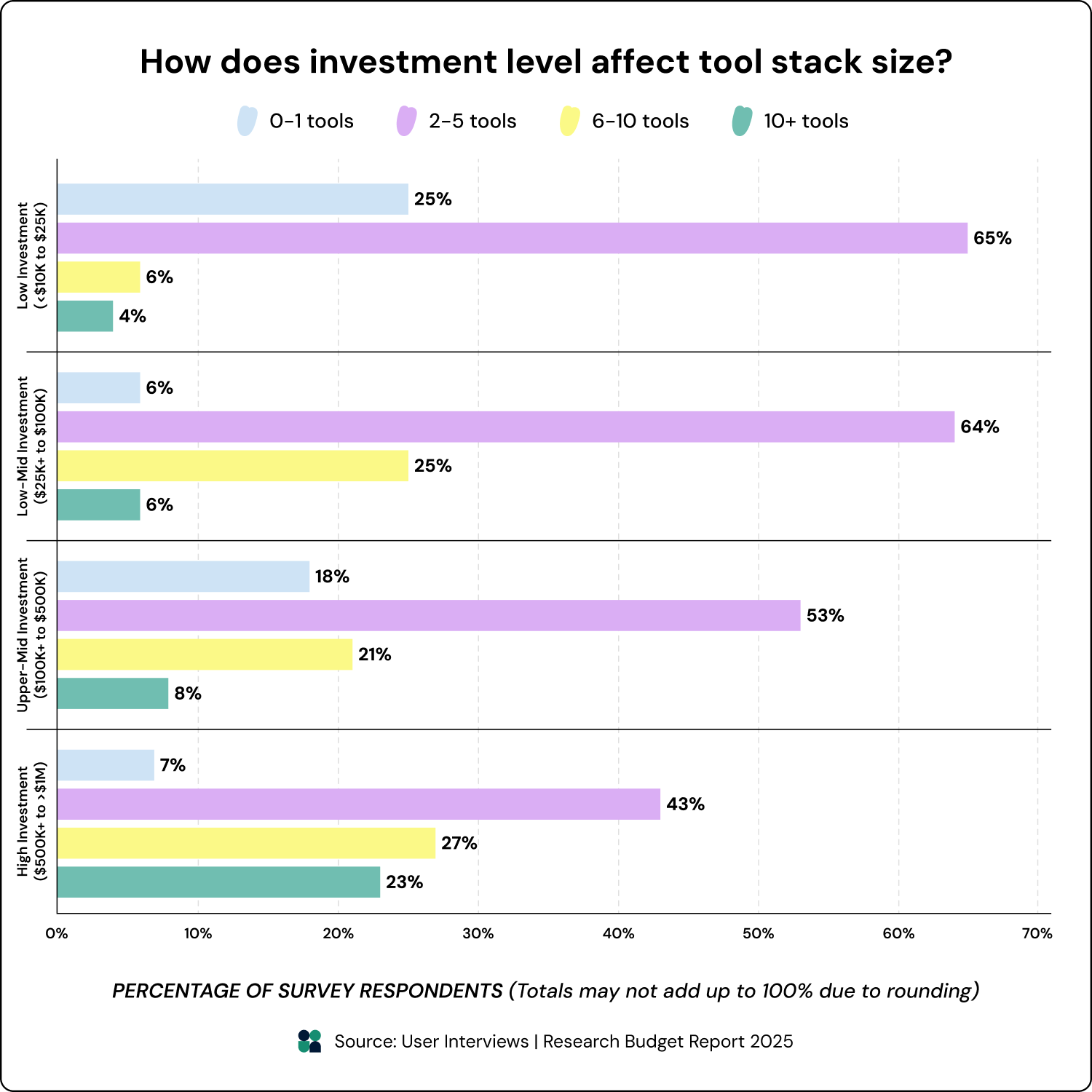
Medium-sized businesses use the most research tools
The sweet spot of 2-5 tools remains the most common stack size for small, medium, and large businesses. However, medium-sized businesses show a higher concentration of larger tool stack sizes compared to small businesses and large enterprises. Of medium-sized businesses, 43% had a tool stack size >6, compared to only 24% of large businesses and 16% of small. One reason for this might be that medium-sized businesses likely have the perfect combo of budget size and flexibility for onboarding tools. Small businesses might not have the funds, and large enterprises might have more rigid onboarding requirements and regulations.
“Management thinks that you can just do it by yourself. They’ve already paid you to be the expert. Why do you need tools? Why do you need software?” - A Researcher at a small business
“New tools require use case justification, comparison to other tools in the market, and passing a security assessment to onboard new vendors and tools.” - A Researcher at an enterprise company
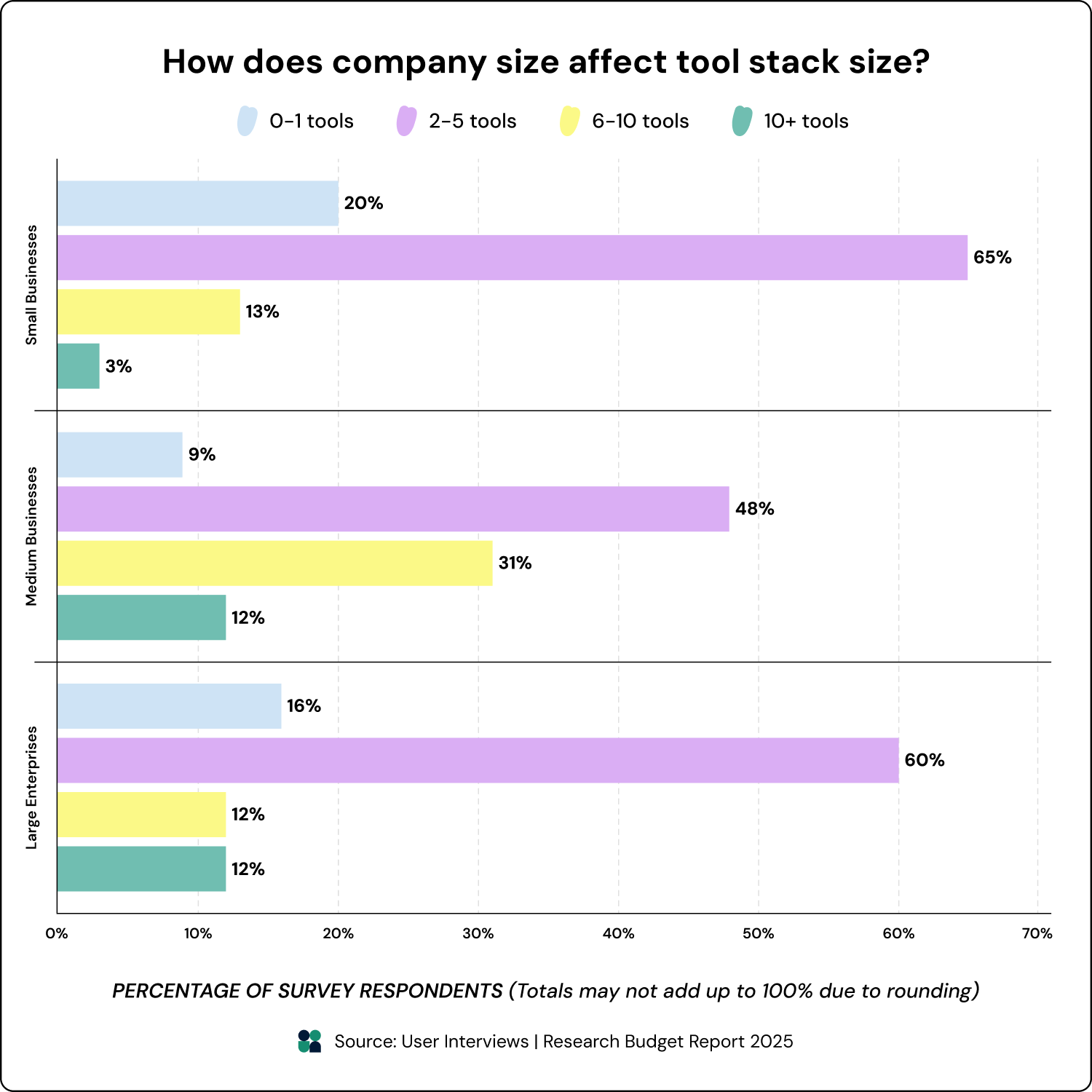
Mature research teams use significantly more tools
No surprises here: The majority of low, medium, and high maturity companies all have research tool stacks of between 2-5 tools. However, there is a clear correlation between maturity and tool stack size: The percentage of teams with 0-1 tools notably decreased and those with 10+ tools notably increased as maturity increased. Might this be that mature teams are more in tune with their needs to advocate for them plus also have the relationships to get those tool investments approved? In fact, no high-maturity teams with more than six tools answered that tools/software was their hardest budget justification.
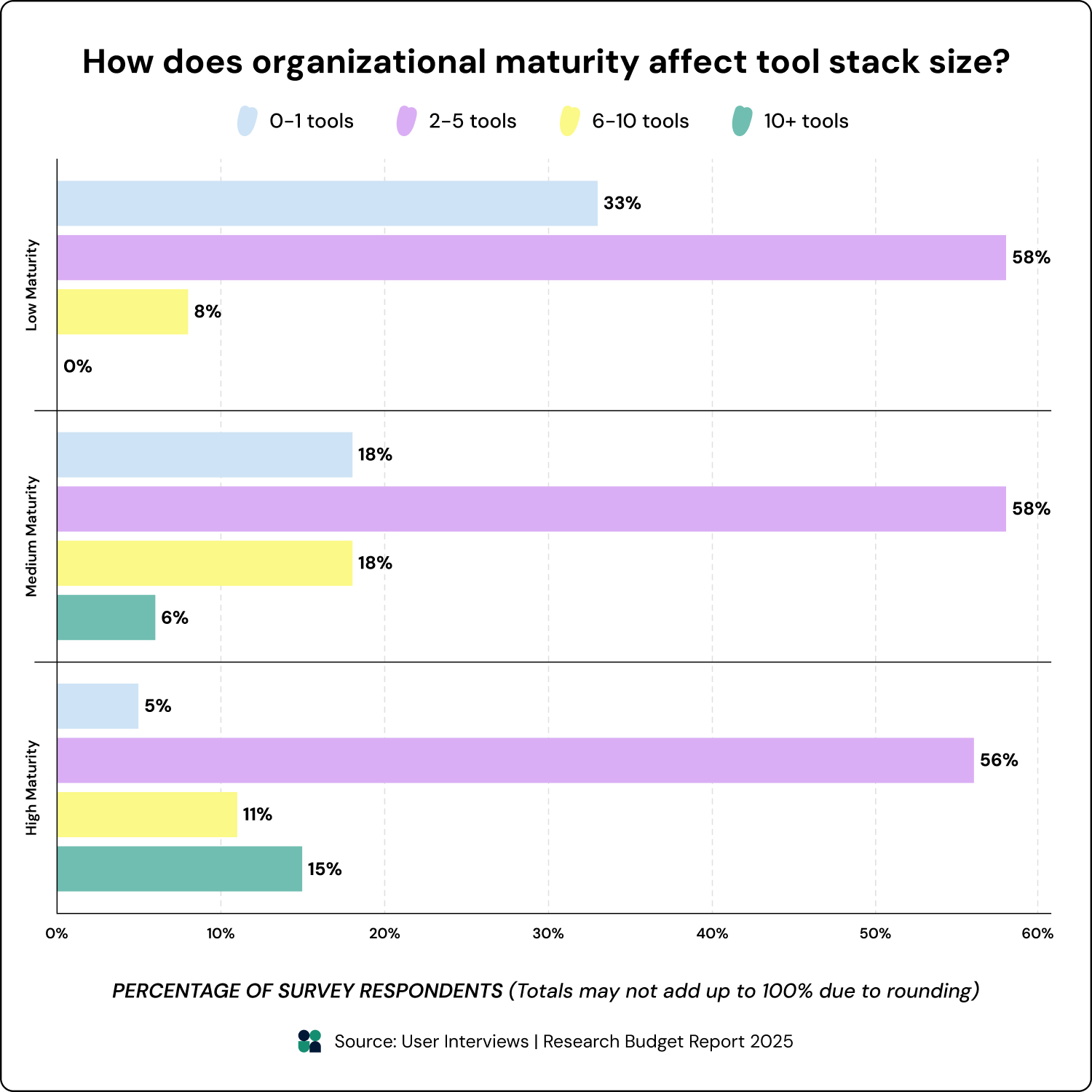
Tech companies use the fewest research tools while finance companies use the most
Again, the most popular tool stack size remains consistent across industries. Surprisingly, computer and technology companies had the smallest research tech stacks, with 78% of teams having less than six tools, followed by education (70%) and healthcare (69%). Perhaps these companies are so tech stack heavy that they don’t have an additional budget for research specific software. Or maybe it could be that these companies are forcing researchers to use general purpose-tools rather than research-specific ones.
“Particularly with free or low cost AI options, it feels like things can be done on the cheap and the expensive tools aren't quite worth the money yet.” - A Product Research VP in the Computer/Technology industry.
“[Our hardest budget justification is] our survey tool because we have a more basic, proprietary tool that can do surveys.” - A Staff Product Researcher in the Computer/Technology industry.
In terms of the largest research tech stack, 41% of finance and economic companies had more than six tools, followed by advertising and marketing (38%).
It seems counterintuitive that a highly regulated industry like finance would have such large tech stacks, as these industries often need to centralize their tool stacks due to data sharing regulations—especially when another tightly regulated industry like healthcare has a slimmer toolset. The underlying reason isn’t clear from this analysis alone—it may be cultural, regulatory, budgetary or something else entirely that would require more investigation to determine.
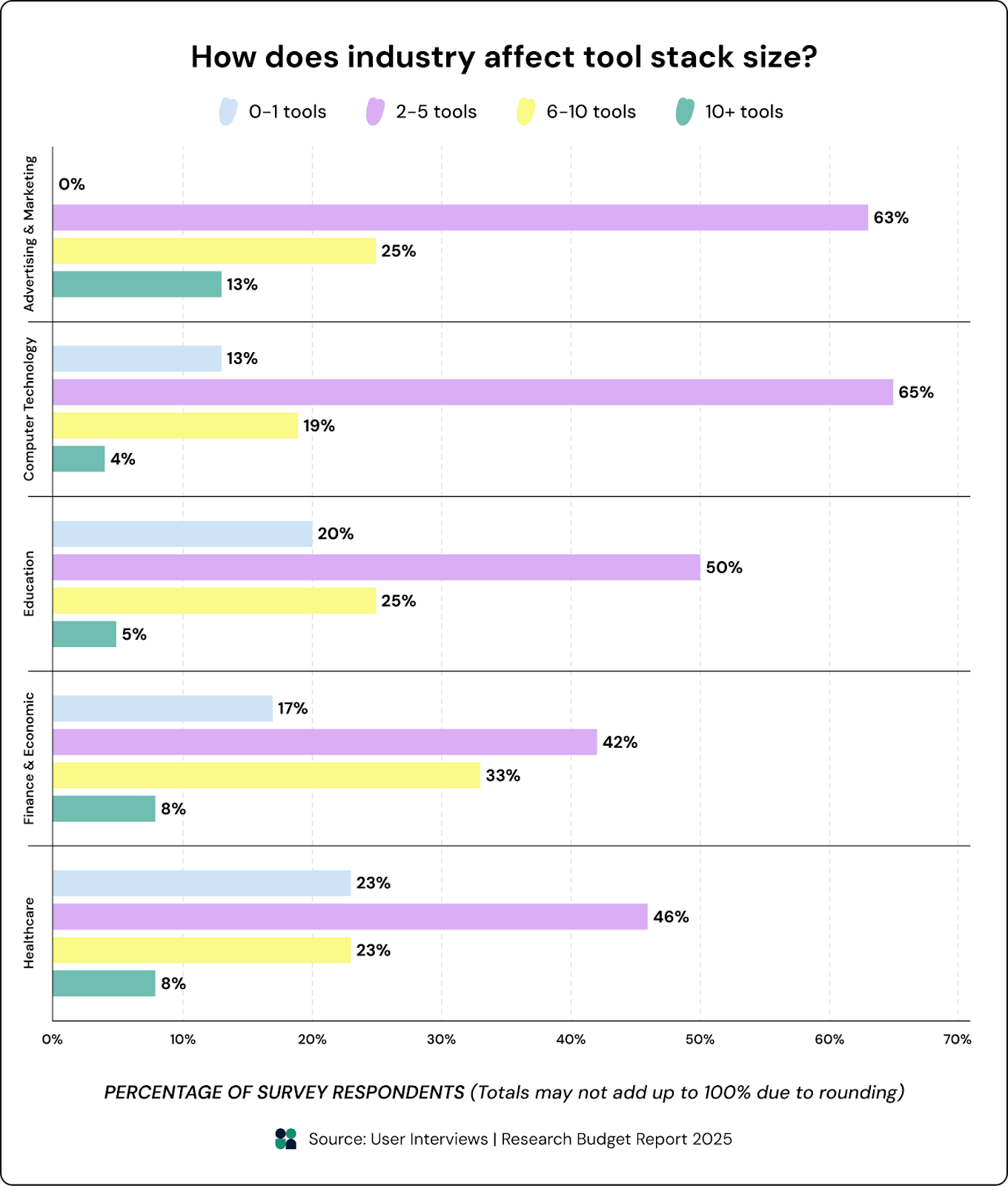
Budget controllers shape tool decisions more than you'd think
Sales, Marketing, and Success teams controlling their own research budgets were way more likely to have robust tool stacks—39% had more than six tools—while Research and ReOps teams weren't far behind at 37%. Compare that to teams whose budgets were controlled by Product/Design (only 7% had more than six tools) or the C-Suite (19%).
Could it be that budget control determines tool access—with self-managing teams (Marketing, Research, ReOps) able to quickly acquire specialized tools while centrally-managed teams (Product/Design/C-Suite) face justification barriers that leave them under-equipped? 36% of those with more operational teams said they’d increase headcount with double the budget, whereas 47% of those centralized teams said they’d increase tools.
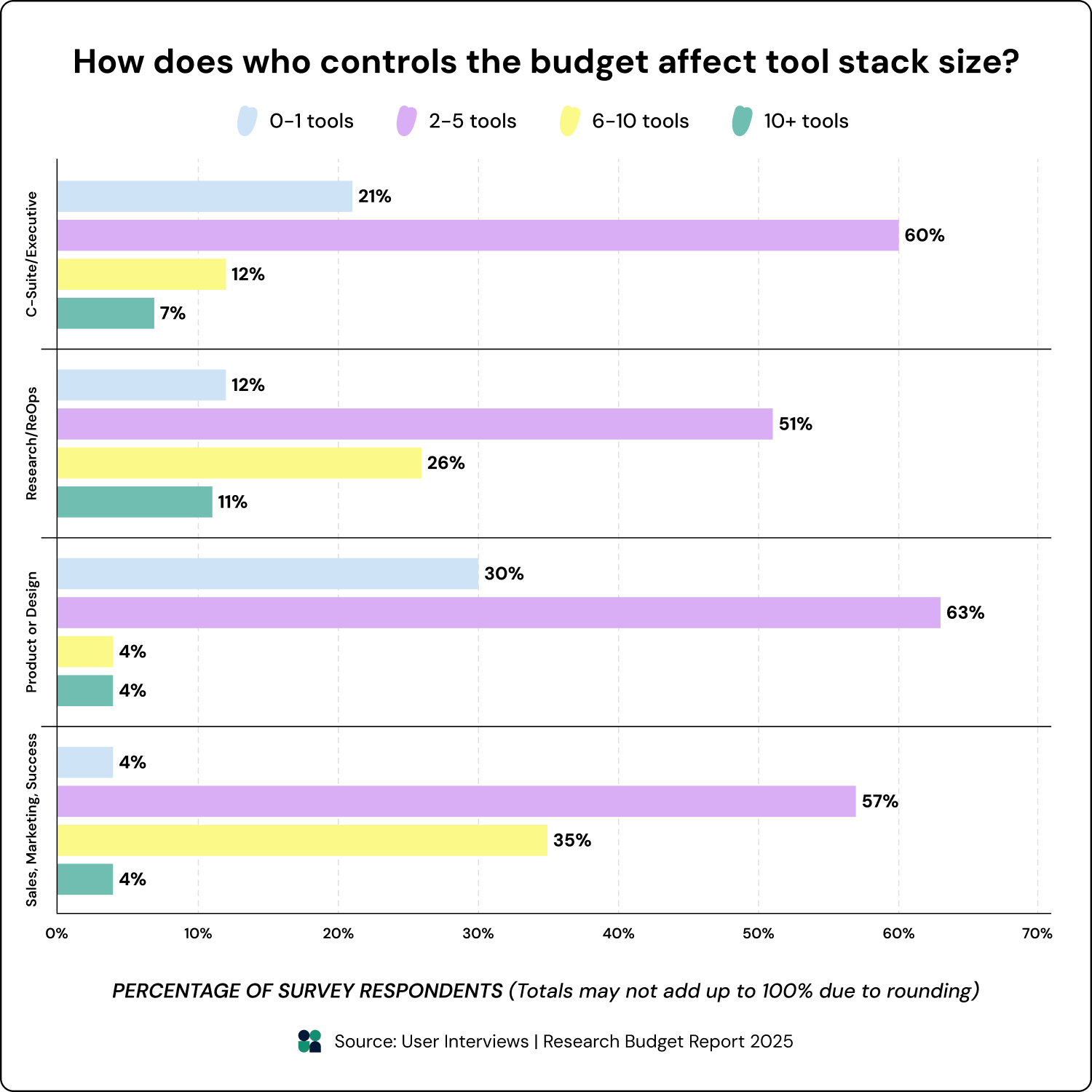
Ready to build a more effective research tool stack? User Interviews is the only tool that lets you source, screen, track, and pay participants from your own panel, or from our 6 million people strong network. Book a demo today.
The more tools, the stronger the relationship between budget and impact
Teams with bigger tool stacks see a stronger connection between their budget and research impact, rating it 4-5 points higher than the baseline 70, while teams with fewer than six tools rate the relationship 3-8 points lower. This makes sense: when you have the right tool for each job, every dollar works harder—you can move faster, dig deeper, and deliver insights that are more polished and actionable.
Additionally, regardless of tool stack size, only 14% of those who rated the relationship between budget and impact above the baseline (71+), mentioned tools as their hardest budget allocation. For those rating it at or below the baseline (<71), it was 29%.
It may be that teams with robust tool stacks have made deliberate investments in their capabilities, building research toolkits that can tackle diverse challenges efficiently. Meanwhile, teams working with limited tools could be more constrained in generating the best outputs. Our data suggests that more tools don't just make teams feel more effective—they actually enable higher-impact research that stakeholders can see and value.
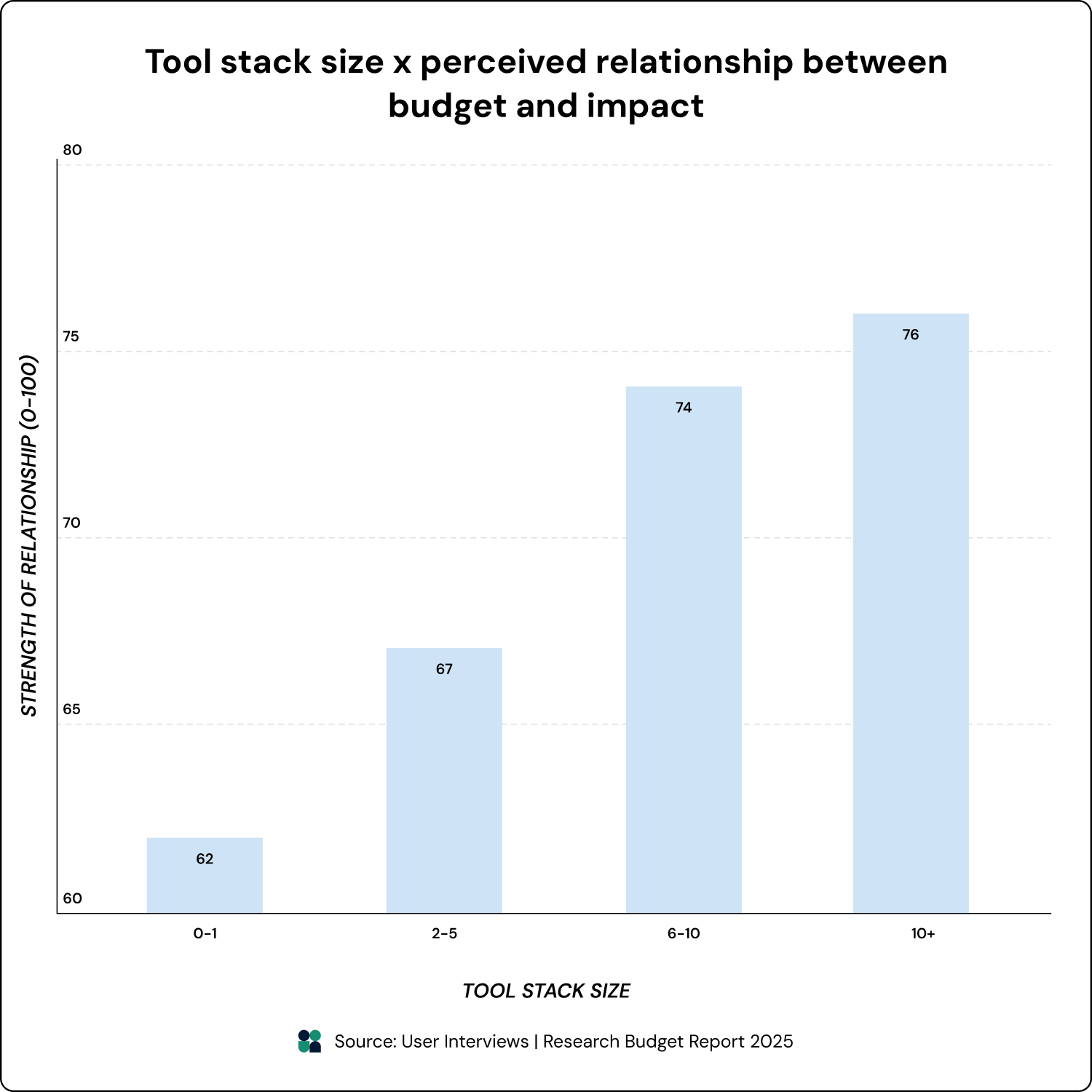
The more tools, the more satisfied teams are with their budgets
A similar correlation appeared when looking at how satisfied participants were with their budgets and tools. The larger the tool stack, the more teams were satisfied or very satisfied with their budgets: only 14% of those with 10+ tools were dissatisfied with their budgets, compared to 52% of those with 0-1 tools. While dissatisfaction rates for those with 2-5 tools weren't that different from larger tool counts, there was a huge gap in satisfaction: only 44% of teams with the most common tool stack size said they were satisfied with their budget, compared to 77%-80% of those with tool stacks greater than six. When teams have the tools they need to do their job well, they feel like their budget is actually working for them—even if the dollar amount stays the same.
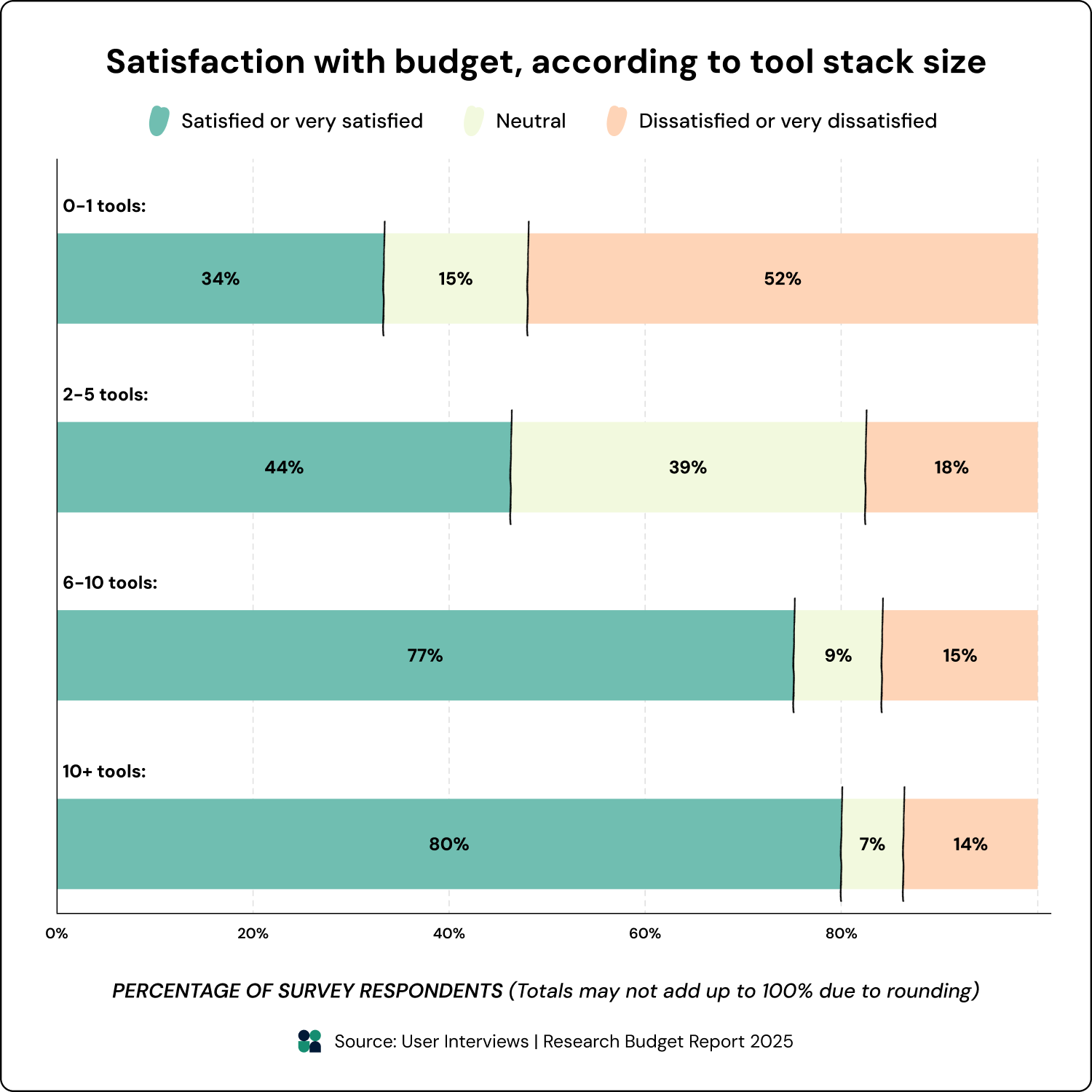
Well-equipped research teams don't just feel more effective—they actually deliver stronger impact that stakeholders can see and value
The data don’t lie: a robust tool stack means more effective–and efficient–research. It’s not about having the latest software, but more about allowing teams access to the capabilities to turn insights into action without constantly hitting roadblocks.
If you're struggling to justify tool investments or feeling stretched thin with your current setup, you're not alone—but you also don't have to stay there. The teams reporting the highest satisfaction aren't just lucky with bigger budgets; they've made strategic investments in tools that solve real problems.
Whether you control your own budget or need to build a case upward, the evidence is clear: the right tools don't just make your work easier—they make your research more impactful.
Looking to bulk up your tool stack? Check out these resources



















